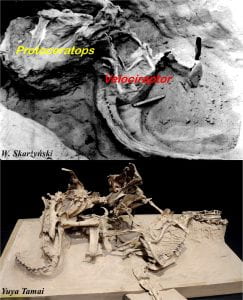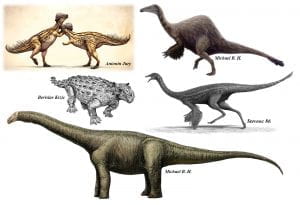This is Part Two of a blog about these expeditions – For Part One, follow this link!
Guest Author – James Ormiston
Bristol Palaeontology MSci Graduate / Palaeo Artist
Mongolia’s ancient underbelly had proved so productive that after suspending fieldwork for one year, the Polish returned in 1967 for another three year stint. This was a smaller scale operation, like in 1963, aimed not at excavating but prospecting. They were accompanied this time by only one member of the Mongolian team for each year, joined also by a car and driver. Returning to the Flaming Cliffs in search of Cretaceous mammals, this cluster of mini-expeditions turned out 20 mammal specimens, as many lizards and a crocodilian.
In the months leading up to the historic 1969 landing of Apollo 11 on the dusty surface of the moon another agreement was signed, organising two more large-scale expeditions in 1970 and 1971. Now they were battle-hardened and prepared for the conditions that awaited them, knowing that enduring these hardships had the potential to reveal yet more amazing secrets from Mongolia’s distant past.
Both expeditions were to be led by Kielan-Jaworowska on the Polish side, and Barsbold on the Mongolian side (although he would not join them in the field, only visit). Knowing full well the importance of adequate transport, this time several extra trucks were hired to work alongside the Polish and Romanian vehicles brought with them. Other than that, the expeditions were organised in the same way as before (one notable exception being that the Polish side covered all costs, rather than splitting them). The Nemegt Basin and Flaming Cliffs remained their objective.
The Upper Nemegt beds produced a number of interesting specimens within the two months spent there by the assigned team. Yet more skeletons of Tarbosaurus were found, along with one skeleton of another familiar dinosaur: Saurolophus angustirostris. This species was the second named of its genus, the first being S. osborni discovered by Barnum Brown in 1911 on the other side of the Pacific. S. angustirostris had been found in the Nemegt Basin by the Russian-Mongolian expeditions of the post-war period. After being named by Russian palaeontologist Anatoly Rozhdestvensky, it became the most commonly found hadrosaur in Asia. Other finds included a new dome-headed dinosaur (pachycephalosaurid) comprising a complete skull and some of its post-cranial skeleton. The Lower Nemegt beds were also investigated, as Yefremov’s Russian team had thought few if any fossils were to be found in them. Things couldn’t have been further from the case. Almost 100 lizards were found, more specimens of Protoceratops, mammals, eggs and an ankylosaur. The team at the Flaming Cliffs made very similar discoveries, and the expedition was wrapped up in October 1970.
Once again, much of the equipment remained in Ulaanbaatar through the winter, being topped up and renewed in April 1971. The expedition’s return to the Nemegt Basin saw yet more specimens of lizards and mammals being recovered. Within the basin, at a site called Khulsan, an unknown ankylosaur was discovered about 4 metres up a cliff side. Such a prize was worth pursuing despite its inconvenient location, and so a difficult excavation using scaffolding to scale the cliff followed. The expedition then moved back to Altan Ula, where the sauropod skeleton had been found 1965. In 6 weeks they found yet more bones of Tarbosaurus, Saurolophus, various ornithomimids, turtles and another large ankylosaur. Things continued to proceed very well throughout July, and in early August the team wrapped things up in Altan Ula and continued to a site to the west of the Flaming Cliffs; Toogreeg. Although it would be the final location visited by the expedition, Toogreeg would go down in palaeontological history as the site of one of the most fascinating fossil discoveries ever made.

Searching in a golden Cretaceous sandstone already abundant with dinosaur eggs and bones, the expedition unearthed two dinosaur skeletons which seemed to be almost interlocked with each other. The species involved were easily identifiable as familiar locals: Protoceratops andrewsi and Velociraptor mongoliensis. But the key difference here was the state of their preservation. The pair had died whilst in physical contact, with the Velociraptor grasping Protoceratops’ head. Although initial reporting of this find was split between theories of combat and drowning, the Polish account settled on the former explanation, and that has been the one to persist to this day. This snapshot of brutality in the pair’s final moments painted an increasingly vivid picture as the specimen was prepared and examined over the following years and decades. It became generally accepted that the fight ended with both animals being buried in a collapsing sand dune. Some theorise (using analysis of sclerotic rings of the eye) that Velociraptor may have been nocturnal, and Protoceratops only active some hours of the day, so the incident could have occurred at twilight. The Velociraptor had seemingly managed to use its sickle-shaped toe claw to stab its prey’s neck, but had also suffered itself a broken arm. Had Protoceratops’ hard beak caused the injury in retaliation before their demise?
The “fighting dinosaurs” fossil was a suitably spectacular bookend to a saga of intrepid expeditions by the Polish and Mongolian Academies of Science. As the vast amount of specimens were picked through, described and catalogued, more and more information new to science followed. The sauropod skeleton found by the 1965 team was named in 1977 and is now thought to be related to the titanosaurs, being named Opisthocoelicaudia skarzynskii. It remains the only other sauropod than Nemegtosaurus to be found in its formation. The huge forelimbs found by Zofia Kielan-Jaworowska remained a mystery for some time, and it wasn’t until the 21st Century that enough remains were recovered (and repatriated from poachers) to say for certain what kind of theropod it was. Initially it was thought to be a carnosaur of some sort (along with such carnivorous giants as Giganotosaurus). But after re-examination and the emergence of almost all other elements of the skeleton, Deinocheirus (“horrible hand”), as it was named, turned out to be a sail-backed form of early omnivorous ornithomimid.
Another new ornithomimid was named in the wake of the expedition in 1972; the giant skeleton also discovered by Kielan-Jaworowska in 1964. Her colleague Halszka Osmólska, together with Roniewicz and Barsbold, named the 6 metre long giant Gallimimus (“chicken mimic”). It went on to become one of the best known dinosaurs in popular culture, thanks to its brief appearance running alongside Sam Neil in Steven Spielberg’s blockbuster adaptation of Michael Crichton’s Jurassic Park. Two new genera of ankylosaur were named by team member Teresa Maryańska in 1977 as Saichania (Mongolian for “the beautiful one) and Tarchia (after the Mongolian word for “brain” – “tarkhi”). Osmólska and Maryańska would also name three new pachycephalosaurs (Homalocephale, Prenocephale and Tylocephale) from the expedition, and continue a long association with working on and naming dinosaurs found in the region.

This is one of the many profound legacies left by the Polish-Mongolian expeditions – it was one of the first instances of a palaeontological expedition with a strong female presence. Even in the following decades, palaeontology as a science struggled to shrug off the historical stereotype of bearded old men with shovels (important as the discoveries by that demographic may have been). As with any science, it was, as demonstrated by Mary Anning’s inability to join the Geological Society in the 19th Century, for a long time the province of men and men alone. Not only did the Polish expeditions include multiple female researchers, but in the case of Zofia Kielan-Jaworowska it came to be that some were actually led by them. Many of the most important discoveries were made, described and published by said women. Kielan-Jaworowska, Maryańska and Osmólska would go on to become renowned and respected researchers. Osmólska has even had multiple genera and species named after her, such as Halszkaraptor and Citipati osmolskae, and was included as editor of David Weishampel’s reference book Dinosauria, along with contributing work on a chapter about oviraptorosaurs.
Mongolia has continued to be something of a Mecca for palaeontological expeditions, and that is unlikely to change, but as it became more well-known an increasing problem began to arise: fossil poaching. UNESCO has marked the Gobi Desert for its near-unparalleled fossil discovery rate and quality, but despite unauthorised fossil digging and sale being illegal in Mongolia it has still happened with alarming frequency. Deinocheirus, for example, may have remained a mystery were it not for other elements of its skeleton being intercepted on the private market. The only known skull had been from Mongolia to Japan to Germany, all in private hands, before a Belgian researcher was given a tip-off and it finally found its way to a museum. The rest of the specimen had been left behind in Mongolia un-excavated and partly vandalised, only for palaeontologists to find it after the fact (personal items left by the poachers revealed their involvement). Evidently after the famous sale of the T. rex specimen “SUE” in the 1990s for over $8 million, fossil poachers knew that the bigger the dinosaur, the bigger the pay-out. Subsequently a specimen of Mongolia’s own Tarbosaurus, aesthetically very similar to T. rex, was caught under auction in the U.S. in 2012 and an effort was made to return it. To the average buyer, Tarbosaurus and T. rex no doubt look very similar. But to anyone with a strong interest in the field the mere name of Tarbosaurus immediately tells you it is from Mongolia, and therefore it must have been collected and exported illegally.
From then on many more fossils were repatriated back to Mongolia; that same year over 20 more fossils were caught, and as recently as 2016 tens of fossils have appeared and been reclaimed from U.S. auction houses. With each fossil returned, not only do the people of Mongolia get some of their prehistory back, but it sets an example for private collectors to avoid accepting more finds from the country.

